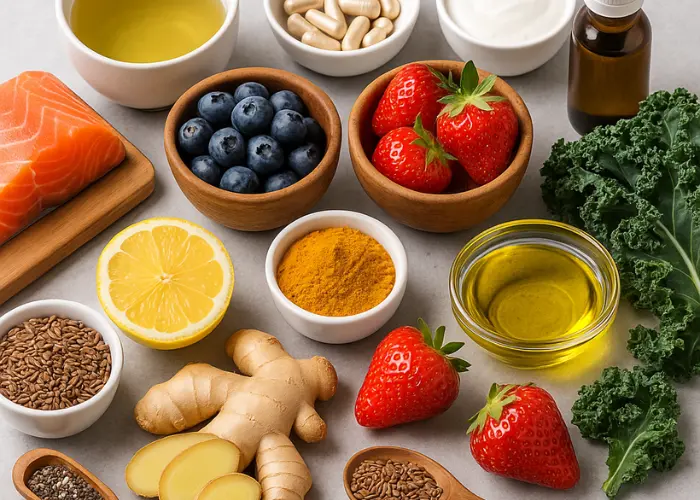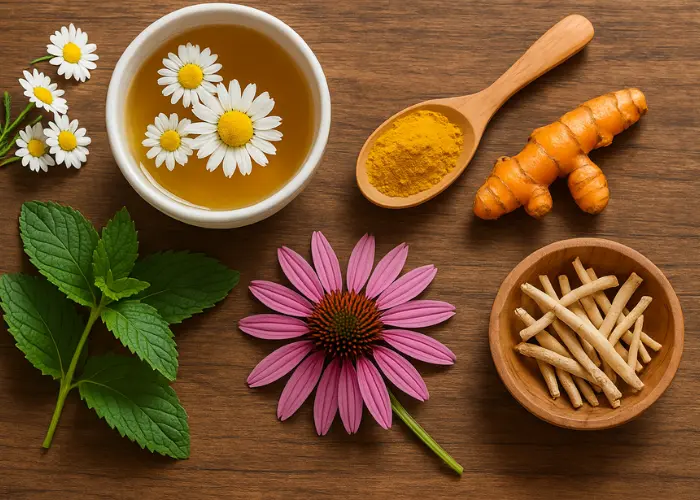Inflammation is your body’s natural way of defending itself from harm. While short-term inflammation helps protect you from injury and infection, chronic inflammation can quietly contribute to long-term health issues, such as joint pain, fatigue, and even heart disease.
The good news? Many natural remedies for inflammation are simple, affordable, and backed by science. In this article, we’ll explore 10 of the most effective natural ways to calm inflammation and support your body’s overall well-being—without resorting to harsh medications.
1. Turmeric: The Golden Anti-Inflammatory
Turmeric contains curcumin, a compound well-known for its powerful anti-inflammatory properties. Studies suggest curcumin can reduce markers of inflammation and even ease symptoms of arthritis when taken consistently 1.
Tip: Try adding turmeric to soups, smoothies, or golden milk. For better absorption, combine it with black pepper.
2. Ginger: Nature’s Soothing Spice
Ginger has long been used in traditional medicine for its warming, calming effects. Modern research confirms it’s effective for reducing inflammation, particularly in muscles and joints after exercise 2.
Enjoy: Ginger tea, fresh ginger in stir-fries, or smoothies.
3. Omega-3 Fatty Acids: Fats That Heal
Omega-3s, found in fatty fish like salmon, flaxseeds, and walnuts, play a major role in reducing inflammation throughout the body. The National Institutes of Health notes that omega-3s help regulate the body’s inflammatory response 3.
Add to your diet: Wild-caught salmon, chia seeds, flaxseed oil, or fish oil supplements.
4. Green Tea: Antioxidant Powerhouse
Green tea is rich in polyphenols, especially EGCG (epigallocatechin gallate), which has been shown to reduce inflammation and protect cells from damage. It’s a simple daily habit that can deliver long-term benefits.
Drink: 1–3 cups per day for the best effect.
5. Berries: Tiny Fruits, Big Impact
Berries such as blueberries, strawberries, and raspberries are loaded with antioxidants like anthocyanins, which help fight inflammation and oxidative stress.
Snack idea: Add a handful of berries to your oatmeal, yogurt, or salad.
6. Leafy Greens: Nutrient-Dense & Anti-Inflammatory
Spinach, kale, and Swiss chard are packed with vitamins, minerals, and fiber. These leafy greens are known to lower inflammatory markers and improve immune function.
Pro tip: Aim for at least one cup of leafy greens daily—either raw or lightly cooked.
7. Probiotics: Gut Health = Less Inflammation
A healthy gut can influence how much inflammation is present in your body. Probiotic-rich foods like yogurt, kefir, and fermented vegetables support the growth of beneficial gut bacteria, which in turn help manage inflammation.
Try: Adding fermented foods to your meals or taking a daily probiotic supplement.
8. Extra Virgin Olive Oil: Liquid Gold for Your Health
A staple of the Mediterranean diet, extra virgin olive oil contains oleocanthal, a compound that mimics the anti-inflammatory effects of ibuprofen.
Use: As your main cooking oil or drizzle over salads and veggies.
9. Regular Movement and Gentle Exercise
You don’t need intense workouts to reduce inflammation—moderate activities like walking, yoga, and stretching can significantly lower inflammation markers.
According to the CDC, regular physical activity helps reduce the risk of chronic inflammatory diseases and improves overall health 4.
10. Mindfulness and Stress Reduction
Chronic stress can increase inflammation in the body. Practices like meditation, deep breathing, and mindful journaling have been shown to help reduce stress and support your immune system.
Start with: 10 minutes a day of deep breathing or guided meditation.
Conclusion: Small Changes, Big Results
Managing inflammation naturally isn’t about quick fixes—it’s about making small, consistent choices that support your body every day. From adding turmeric to your meals to taking a brisk walk in the morning, each step counts.

Which of these natural remedies have you tried—or plan to try?
Leave a comment below and let’s chat about your experience!
Or feel free to share this article with someone who’s on their own wellness journey.



